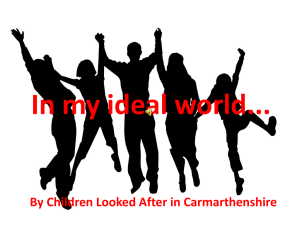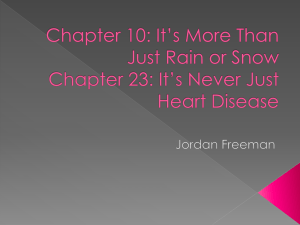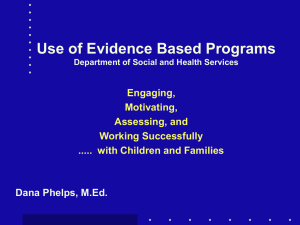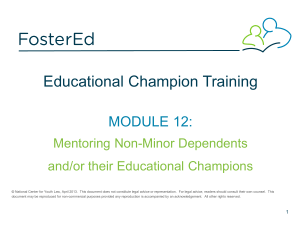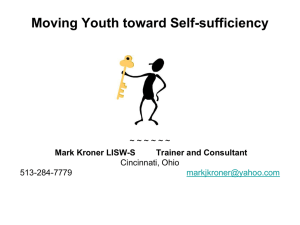Aspects Of Treatment
advertisement
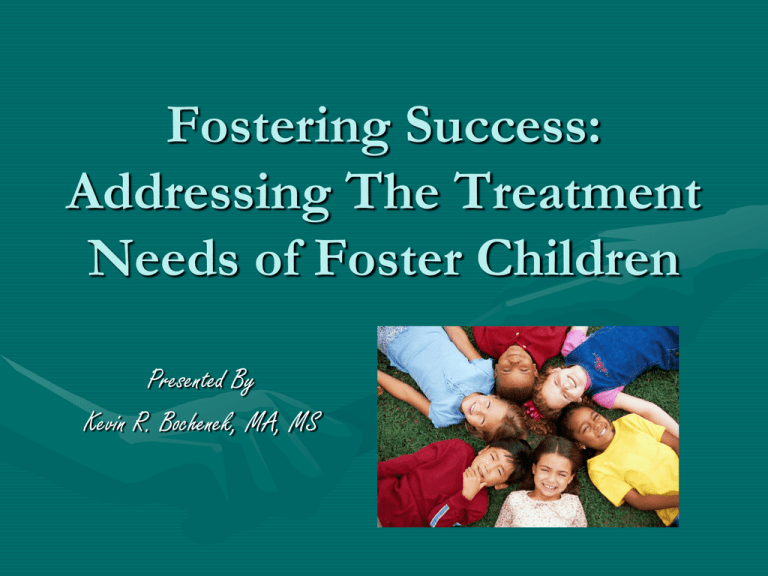
Fostering Success: Addressing The Treatment Needs of Foster Children Presented By Kevin R. Bochenek, MA, MS Educational Learning Goals: • Participants will be sensitized to issues related to children in foster care. • Participants will learn about important therapeutic themes and ways children react to the foster care experience. • Participants will explore various therapeutic issues, aspects of treatment, and helpful therapeutic techniques. Factors Influencing Development: • Eight factors which influence development will be explored in the context of how they relate to the foster care experience. Factors Influencing Development: • Heredity: Certain aspects of development are influenced by biological factors such as genes. Factors Influencing Development: • Level Of Environmental Stimulation: Enriched environments that offer a high degree of stimulation influences development positively. Healthy stimulation should involve all of the senses. Factors Influencing Development: • Modeling: Children will learn from their role models in their environments. Humans are truly “copycats”. Factors Influencing Development: • Family Culture: Family values and culture influence the child’s personality development. Factors Influencing Development: • Birth Order: A child’s birth order in the family can influence the rate of development and the child’s overall personality. Factors Influencing Development: • Level Of Support: How supportive and attentive the caregivers are will influence a child’s development. Included in this area would be whether or not the birth was wanted, maturity of the caretakers, and support from relatives. Factors Influencing Development: • Style Of Parenting: Parenting style can influence certain personality variables and overall development. Dictator-style parents run the risk of having children who are overly dependent and who act out of fear. Permissive parents may have children who are unable to follow basic rules and limits established in structured environments. Factors Influencing Development: • Expectations: Development is influenced by the expectations of caregivers and those in the child’s environment. Your expectations should not be too low or high. Diagnostic Issues: • It is frequently difficult to diagnose foster children. It is sometimes unclear if behaviors are part of a diagnostic cluster or the result of coping with being in foster care. • Some behaviors look like one diagnosis (i.e.– AD/HD) while they may actually be something else (i.e.– anxiety). • Substance exposure in foster care complicates diagnosing. They can exhibit very impulsive, explosive, and labile behavior. It is unclear if those children should be diagnosed as AD/HD, Bipolar Disorder, or Intermittent Explosive Disorder. Diagnostic Issues: • It is helpful to understand the child’s premorbid functioning and to know the biological family’s medical and mental health history. • Common diagnoses: Adjustment Disorder, Oppositional Defiant Disorder, Dysthymic Disorder, Intermittent Explosive Disorder, and Reactive Attachment Disorder. Ways Children React To Foster Care: 1. The Needy Child: He is clingy and has indiscriminate attachments; likes a lot of physical touch, does anything to relate to you and others; constantly wants to please you and fears rejection; is at risk for victimization. • Therapeutic Goals: Teach independence and appropriate boundaries, teach personal safety, and educate child on how to deal with strangers Ways Children React To Foster Care: 2. The Control Freak: This child was often parentified; has difficulty accepting authority and attempts to relate to adults as a peer; child likes to take charge; often the child is overly neat and organized; does not trust that adults will be in control; often perceived as annoying to adults. • Therapeutic Goals: Help the child explore trust issues; help child learn to take an appropriate child role; establish appropriate adultchild boundaries; offer clientdirected time in therapy. Ways Children React To Foster Care: 3. The Distant Child: This child keeps his distance from you; becoming too emotionally connected to you or anyone is too threatening to him; this child needs space and time to feel close to you; often this child never fully unpacks at his foster home; this child has great difficulty sharing thoughts and feelings. • Therapeutic Goals: Help the child learn to identify and share feelings; focus on building a trusting relationship; help the child with communicating thoughts and needs; help the child to engage with others; help child label feelings to initiate discussion and understanding Ways Children React To Foster Care: 4. The Volcanic Child: This child is like a volcano ready to explode; he has a lot of anger about his situation this is frequently displaced to others; he is often oppositional; sometimes he can be well-behaved for days before exploding. • Therapeutic Goals: Teach anger control and impulse control; find appropriate physical outlets for the client; teach relaxation skills; develop a plan to help child when angry and involve foster parents and/or school staff with the plan; give a lot of support to the foster parents. Ways Children React To Foster Care: 5. The Avoidant Child: This child avoids issues surrounding foster care; child will disagree with need for therapy; child avoids sharing feelings; acts as if he has two separate worlds; often disowns his biological family; often acts as if everything is fine despite hurting on the inside. • Therapeutic Goals: Help the child to explore his feelings; develop a trusting therapeutic relationship over time; be there for the client and do not push too hard during the initial stage of therapy. Ways Children React To Foster Care: 6. The Manipulative Child: Because of his experiences with neglect, this child often uses people to get his needs met at any cost; can be charming; will strive to gain your trust and then will do something to break that trust. • Therapeutic Goals: Teach about the importance of honesty in relationships; confront manipulation; assist child in finding ways to get needs met appropriately; help child to develop genuine relationships Ways Children React To Foster Care: 7.The Anxious Child: This • Therapeutic Goals: Offer a child is very cautious; often lot of reassurance; help the functions like “a deer in child to know what is coming the headlights”; often next; avoid surprises; teach worried about punishment relaxation techniques or disappointing adults; fears & worries tend to be reality-based. Five Essential Therapeutic Themes: • Eliminating Responsibility • Building Self-Worth • Believing In Yourself • Maintaining Connections • Developing A Future Orientation Therapeutic Issues: • Feeling different • Enormous sense of grief and loss • Am I worthy of love? • Need for control • Feeling responsible for younger siblings Therapeutic Issues: • • • • • • Learning to trust Learning to be a kid Anxiety– What is next? Fitting in Caught between two worlds Dealing with disappointments • Aging out • Coming to terms Aspects Of Treatment: Support To The Foster Parents: A primary goal of therapy for foster children is to offer support to the foster parents in order to preserve the placement. Support includes involving foster parents in the treatment process, conducting family therapy, offering parenting suggestions, allowing foster parents to vent, and to offer phone calls or emails in between sessions. Aspects Of Treatment: The Therapeutic Relationship: It is essential that the therapist take adequate time to develop a trusting therapeutic relationship. The child should be clear on confidentiality policies. It is often helpful when you want to share information about a session to get the child’s permission or have the child tell the other party. The therapist must be sure not to put herself in a situation in which she attempts to rescue the client. Some children will try to manipulate the therapist to get their needs met. Therapeutic relationships with foster children can be intense. The therapist provides a corrective relationship. Aspects Of Treatment Three Key Issues: Consistent therapeutic relationship is important. Treatment issues are complex. Course of treatment– Healing takes time. Aspects Of Treatment: Individual Therapy: The therapeutic process is sometimes more important than the content. Consistency is extremely important in therapy with foster children. It is helpful to give the client some control of the session. Reducing anxiety by teaching relaxation techniques is often helpful during the initial stage of therapy. The therapist must be comfortable confronting tough feelings and issues directly. The therapist needs to communicate closely with the foster parents about the therapy process and goals. Aspects Of Treatment: Sibling Work: Many siblings in foster care do not have healthy relationships with each other. Working with siblings can often be challenging; however, it can be beneficial to improving siblings relationships, stabilizing a placement, sharing common experiences, and working on social skills. Other goals might include processing why they came into care, expressing feelings surrounding removal, discussing adjustment issues, discussing visitation, and developing healthy communication patterns. Aspects Of Treatment: Dyad Work: Putting two foster children together to work on common treatment goals can be very useful. A therapy dyad can be a useful precursor to placing a child in a group. Many goals can be accomplished in the dyad including processing feelings of loss, social skills, communication skills, and relationship-building. Aspects Of Treatment: Group Therapy: Group therapy can be a powerful modality for foster children because they can share common issues and realize they are not alone. Care should be taken in selecting children for a group. Groups could be process-oriented or focus on topics such as social skills and anger management. Aspects Of Treatment: Trauma, Loss, and Adjustment Issues: The need for trauma and/or loss work needs to be carefully assessed. Before embarking on trauma work, work with the child at developing some basic coping skills. A supportive therapeutic relationship should allow for the child to feel safe discussing and exploring issues related to adjusting to foster care and to particular placements. Aspects Of Treatment: Attachment Issues: The therapist should involve the foster parents in the treatment to help build healthy relationships and attachments for the child. Therapists should be careful not to have their foster child become too dependent on them. For children who develop indiscriminate attachments, it is important to discuss personal safety and appropriate boundaries. Aspects Of Treatment: Self-Esteem: Stephanie Marston defines self-esteem as “a sense of feeling lovable and capable. When those two things are in sync, a person has high self-esteem.” Help the child develop and explore their identity. Help the child to value their personal history instead of being ashamed of it. Help clients develop mastery and competency, in both subtle and grand ways. Aspects Of Treatment: Coping Skills: Getting needs met appropriately Identifying, exploring, and sharing feelings Tolerating distress and reducing anxiety Communication skills Anger management skills Impulse control skills Problem-solving skills Self-soothing skills Self-care skills Aspects Of Treatment: Social Skills: Teaching social skills is critical in helping children develop appropriate social skills. The Boys Town model of breaking social skills down into component parts and preventative & corrective teaching are valuable ways to approach social skills. Social skills training is most valuable with the support of a reinforcing environment. Role plays are helpful in helping clients learn social skills. Aspects Of Treatment: Teaching Values: Because of placement changes and disruptions, children in care may get minimal training in the area of morals and values. The therapist and the foster parents need to play a critical role in teaching values such as the golden rule. Rosen (1998) suggests the importance of training children in out of home placements in altruism, empathy, generosity, respect for others, and right & wrong. Foster children need to learn to take responsibility for their actions. Aspects Of Treatment: Processing Of Permanency Goals: Children in foster care should be aware of their permanency goal. The therapist should allow ample opportunity for the child to discuss her goal and explore feelings surrounding the goal. If the goal is adoption, all of the child’s feelings surrounding adoptions should be explored. If the goal is termination of parental rights, the therapist must establish a safe place for the child to explore his strong feelings related to the issue. If the goal is reunification, the therapist should work closely with the biological family and help the child develop realistic expectations. If the goal is independent living, this should be incorporated into treatment. The therapist should be one of many preparing the child for independence. Aspects Of Treatment: Reunification Work: If the goal is reunification, active steps should be taken to assist with the process. Family therapy is essential to prepare for reunification. It should be scheduled as frequently as possible. The therapist and foster parents must take a nonjudgmental and supportive posture towards the biological family. It is important to remember that most parents who abuse/neglect their children do love them. Ideally, the foster parents could be coached by the therapist to provide parent training for the family. Aspects Of Treatment: Reunification Work: Biological parents can be taught to give supportive messages to their children regarding their behavior in the foster home. While foster parents are assisting with parent-training, the therapist can work on communication, problemsolving, and coping skills within the family. Solution-focused work is helpful in conducting reunification work. Aspects Of Treatment: Reunification Work: Often the therapist will need to redirect the family back to the reason for the removal to plan for the future. Biological parents often minimize the circumstances surrounding the removal. It is often helpful for the child’s individual therapist to be the family therapist as well. The therapist is a bridge between the biological family and the foster family. The treatment team should be in place prior to the day of reunification. It is important for therapeutic relationships to be established so the biological family will be more inclined to commit to services. Helpful Therapeutic Techniques: • Letter writing • Journal writing in between sessions • Nondirective play therapy • Directive play therapy • Use of toy phone • Creating a memory box • Creating a photo album • Empty chair technique Helpful Therapeutic Techniques: • Creating stories and metaphors • Puppet play with foster child puppet • Teaching clients something in session to build competencies • Play with animal families, dolls, or puppets • Use of art therapy Helpful Therapeutic Techniques: • People who care about me activity • Body drawing • Celebration ritual • Positive self-statement journal • Taking care of a baby doll or stuffed animal • Mapping out history and placements Lessons Learned From Foster Children: • Carl: Repeated re-telling of abuse story is not therapeutic. • Nicholas: Abused kids are hungry for a corrective experience. • Jason: Some foster children are eager to push others away before they pulled away • Jacob & Jaxson: Unresolved anger can lead to time in jail Lessons Learned From Foster Children: • Felicity: Kids can teach adults. • Tyler: Healing and moving on takes time and the power of a loving family. • Anthony: Fitting in at all costs is important to many foster kids. • Joe: Unconditional acceptance leads to healing. Lessons Learned From Foster Children: • Stefano: Foster children are quick to be accused. • Jonathan: Kids can be quite resilient. • Justin: Relationships can help to get through a crisis. • Germancy: Don’t assume a foster child has picked up basic social graces. Pre-teach to foster children. Someone Else’s Child Be there for me… I am someone else’s child. Won’t you be there for me? If not you, then who? Bibliography: Baker, C.B., Burk, R.V., Herron, R.W., & Mott, M.A. (1996). Rebuilding children’s lives. Boys Town, NE: The Boys Town Press. Bowlby, J. (1988). A secure base: Parent-child attachment and healthy human development. New York: Basic Books, Inc. Boyd Webb, N. (Ed.). (1991). Play therapy with children in crisis: A casebook for practitioners. New York: The Guilford Press. Cohen, J.A., Mannarino, A.P., & Deblinger, E. (2012). Trauma focused CBT for children and adolescents: Treatment applications. New York: The Guilford Press. Cohen, J.A., Mannarino, A.P., & Deblinger, E. (2006). Treating trauma and traumatic grief in children and adolescents. New York: The Guilford Press. Bibliography: Combrinck-Graham, L. (Ed.). (1995). Children in families at risk: Maintaining the connections. New York: The Guilford Press. Combrinck-Graham, L. (Ed.). (1989). Children in family contrexts: Prespectives on treatment. New York: The Guilford Press. Delaney, R.J. (2006). Fostering changes: Treating attachmentdisorderd foster children. Bethany, OK: Wood N. Barnes. Delaney, R.J. (2000). The healing power of the family: Illustrated overview of life with the disturbed foster or adopted child. Bethany, OK: Wood N. Barnes. Delaney, R.J. & Kunstal, F.R. (2000). Troubled transplants: Unconventional healing for disturbed foster and adopted children. Bethany, OK: Wood N. Barnes. Bibliography: Gil, E. & Briere, J. (2011). Helping abused and traumatized children: Integrating directive and nondirective approaches. New York: The Guilford Press. Gil, E. (1996). Treating abused adolescents. New York: The Guilford Press. Gil, E. (1991). The healing power of play. New York: The Guilford Press. Hughes, D.A. (1998). Building the bonds of attachment: Awakening love in deeply troubled children. Northvale, NJ: Jason Aronson, Inc. James, B. (1994). Handbook for treatment of attachment-trauma problems in children. New York: Lexington Books. James, B. (1989). Treating traumatized children. Lexinton, MA: Lexington Books. Bibliography: Jarratt, C.J. (1994). Helping children cope with separation and loss. Boston, MA: The Harvard Common Press. Minuchin, P., Colapinto, J., & Minuchin, S. (1998). Working with families of the poor. New York: The Guilford Press. Rosen, M. (1998). Treating children in out of home placements. New York: The Haworth Press, Inc. Temple-Pllotz, L., Stricklett, T.P., Baker, C.B., & Sterba, M.N. (2002). Practical tools for foster parents. Boys Town, NE: The Boys Town Press. U.S. Department of Health and Human Services. (2012). The AFCARS Report.
